Contacts:
Dave White, New York Sea Grant, Recreation/Tourism Specialist, P: 315.312.3042, E:
dgw9@cornell.edu
Oswego, NY, May 17, 2013 - One of four legs of an exciting research mission developed by the Great Lakes Research Consortium took place in Oswego, NY, on May 16, 2013. The mission was housed at SUNY ESF and the Great Lakes Observing System with support from the USEPA; New York’s Great Lakes Research Consortium (GLRC) member schools, i.e., SUNY Colleges at Brockport and Oswego and the College of Environment Science and Forestry (SUNY ESF) in Syracuse NY; and New York Sea Grant.
The photos below this news release show the journey of a high-tech Autonomous Underwater Vehicle, or AUV, launched off the Oswego shoreline at SUNY Oswego at 8:15am.
The 42-pound, 6-foot-long equipment produces intensive data for analysis of nearshore-offshore interactions, fish productivity in Lake Ontario, changes to the lower food web, and algal abundance.
The submarine has side scan sonar and a full payload of sensors, 10 beam Doppler Velocity Log for bottom tracking, and Eco Mapper technology for high-res water quality monitoring; generates data to computer chip, including 3-D survey maps of temperature, turbidity, depth, pH, current, oxygen levels, nutrient levels, etc.
Lead scientist Dr. Greg Boyer, a biochemist at SUNY ESF, is particularly focused on algal bloom in the nearshore freshwater ecological system and how the thermal bar – a seasonal/spring temperature barrier – impacts nutrients in nearshore aquatic environment.
Boyer is known for his work on the chemistry and ecology of freshwater ad marine harmful algal blooms, rapid detection methods for the toxins produces by these organisms, and the impact of blue-green algal blooms on the recreational use of the Great
New York Sea Grant has provided funding for several research projects by Boyer, including a current project on algal bloom in Sodus Bay.
“The autonomous underwater vehicles represent the next wave in environmental sampling of our Great Lakes. No longer do we need to put two people in a boat and send them out for a day putting instruments in and out of the water. We can program these AUVs to leave from shore, go out, travel up and down in the water column, collecting thousands of data points, and then return home,” said research leader Dr. Gregory L. Boyer, chair of the SUNY ESF Department of Chemistry and director of Great Lakes Research Consortium.
“The units we are deploying in Lake Ontario in 2013 are designed for nearshore work, but we also have access to 'gliders' that can go out for weeks to a month at a time. It is truly an exciting time to be a Great Lakes researcher," Boyer added.
The other mission sites included Sodus Point, Rochester and Oak Orchard.
The research is part of the international US-Canada Cooperative Science Monitoring Initiative (CMSI) under Clean Water Act of 1972. CSMI cycles intensive monitoring activities through the five Great Lakes, one lake per year for every five years. This new data for Lake Ontario will be compared with 2008 survey results.
New York Sea Grant will help deliver the analyzed data results to shoreline stakeholders.
“The Great Lakes system forms a unique ecosystem, natural environment, economic engine, recreational resource, and public water supply. The evolution of technology greatly facilitates the scientific study of the dynamics of the individual lakes and the Great Lakes Basin in its entirety. This first-time underwater research on Lake Ontario provides the opportunity to synthesize intense biological, chemical, geological, and other data for use by multiple stakeholder groups from natural resource and fisheries managers to marina operators and angler associations,” said Coastal Recreation and Tourism Specialist Dave White with New York Sea Grant at SUNY Oswego.
On a side note: Great Lakes Observing System in-water buoys –
www.nyglrc.info - are beginning to be deployed for 2013.
Photo Gallery
Preparing to Launch
The AUV
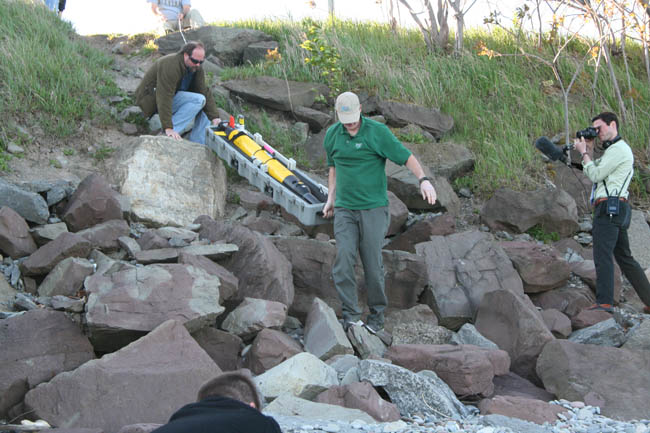
AUV Lake Ontario mission lead scientist Dr. Greg Boyer of SUNY ESF, center, and SUNY ESF Senior Research Support Specialist Mike Satchwell bring the AUV to the shoreline at SUNY Oswego as NPR Innovation Trail reporter Ryan Delaney captures the arrival by camera.
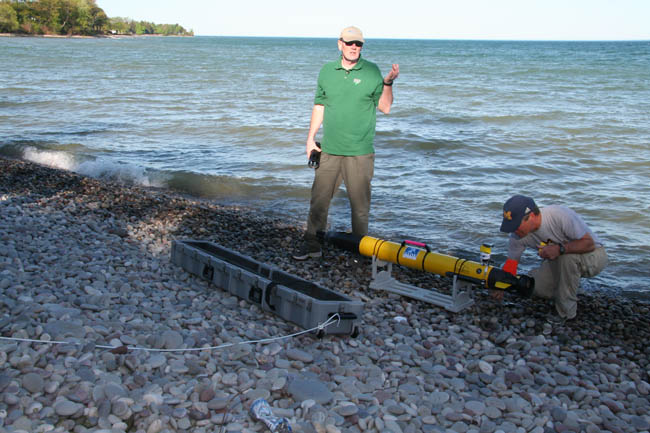
Lake Ontario AUV mission lead scientist Dr. Greg Boyer talks with media as AUV Mechanical Technician Russ Miller prepares the 42-lb, 6-foot-long submarine for launch.
“The autonomous underwater vehicles represent the next wave in environmental sampling of our Great Lakes. No longer do we need to put two people in a boat and send them out for a day putting instruments in and out of the water. We can program these AUVs to leave from shore, go out, travel up and down in the water column, collecting thousands of data points, and then return home,” said research leader Dr. Gregory L. Boyer, chair of the SUNY ESF Department of Chemistry and director of Great Lakes Research Consortium.
“The units we are deploying in Lake Ontario in 2013 are designed for nearshore work, but we also have access to 'gliders' that can go out for weeks to a month at a time. It is truly an exciting time to be a Great Lakes researcher," Boyer added.
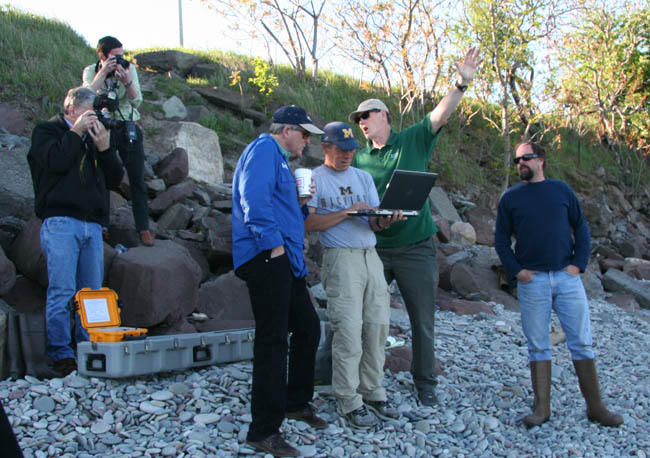
AUV launch partners New York Sea Grant Coastal Recreation and Tourism Specialist Dave White, AUV Technician Russ Miller from the University of Michigan Ann Arbor, and Great Lakes Research Consortium Director Dr. Greg Boyer of SUNY ESF check the computerized grid that the AUV followed. SUNY ESF Senior Research Support Specialist Mike Satchwell waits to put the autonomous underwater vehicle in the water.
“The Great Lakes system forms a unique ecosystem, natural environment, economic engine, recreational resource, and public water supply. The evolution of technology greatly facilitates the scientific study of the dynamics of the individual lakes and the Great Lakes Basin in its entirety. This first-time underwater research on Lake Ontario provides the opportunity to synthesize intense biological, chemical, geological, and other data for use by multiple stakeholder groups from natural resource and fisheries managers to marina operators and angler associations,” said Coastal Recreation and Tourism Specialist Dave White with New York Sea Grant at SUNY Oswego.
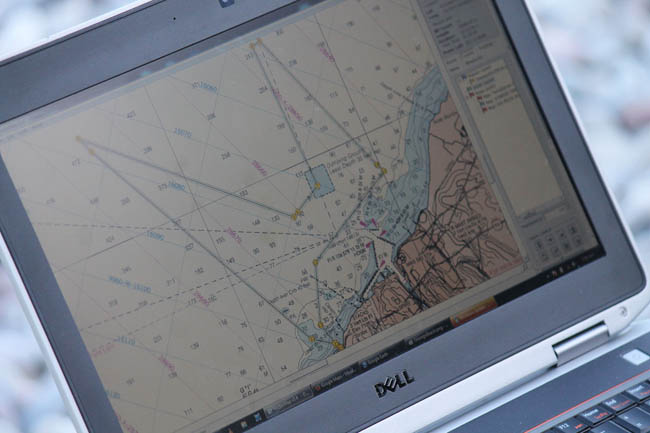
The M-shaped grid pattern the AUV followed on its mission off Oswego.
2nd AUV group: The Launch
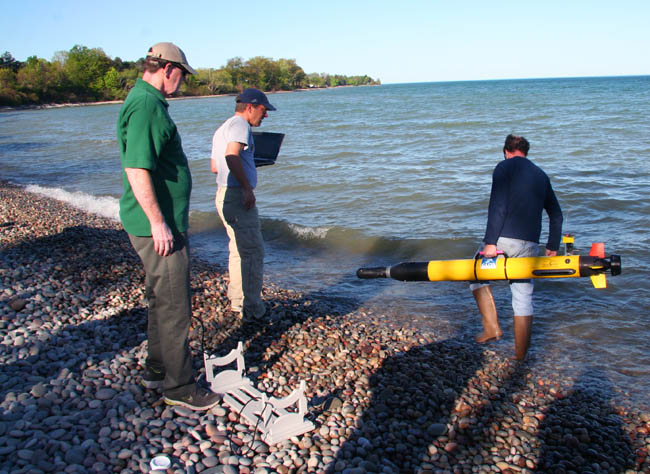
SUNY ESF Senior Research Support Specialist Mike Satchwell walks the AUV into Lake Ontario as Great Lakes Research Consortium Director Dr. Greg Boyer of SUNY-ESF and AUV Mechanical Technician Russ Miller from the Cooperative Institute of Limnology and Ecosystems Research at the University of Michigan Ann Arbor look on.
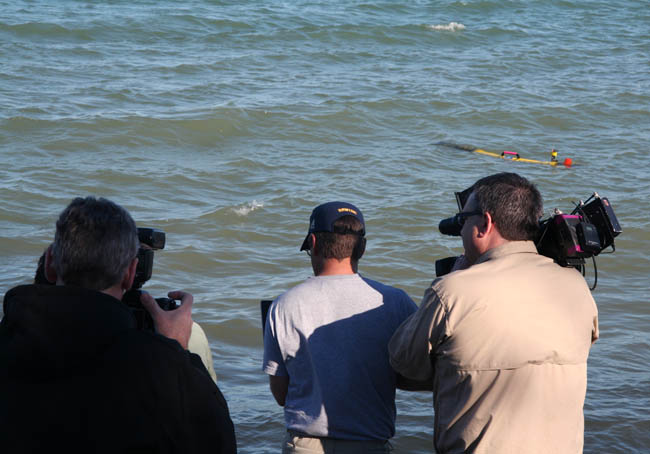
AUV Mechanical Technician Russ Miller from the Cooperative Institute of Limnology and Ecosystems Research at the University of Michigan Ann Arbor uses a laptop computer to check the immediate post-launch functioning of the AUV. He can ‘drive’ the AUV briefly before it goes into autonomous mode to carry out its data collection mission.
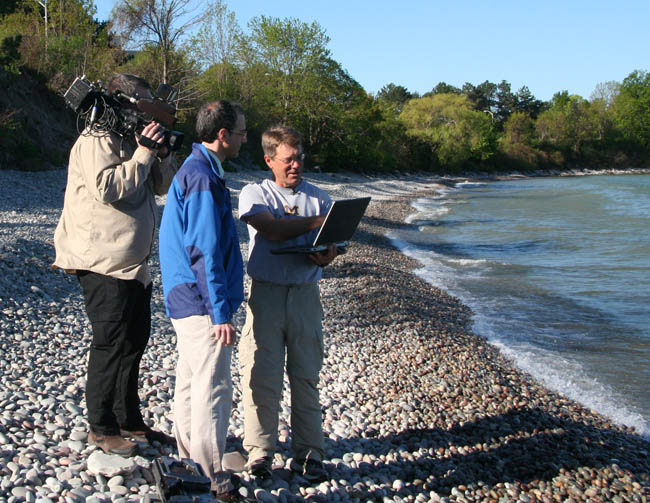
AUV Mechanical Technician Russ Miller from the Cooperative Institute of Limnology and Ecosystems Research at the University of Michigan Ann Arbor shows Jeff Kulikowski of WSYR NewsChannel9, Syracuse, the computer tracking of the AUV.
On-Shore AUV Public Education
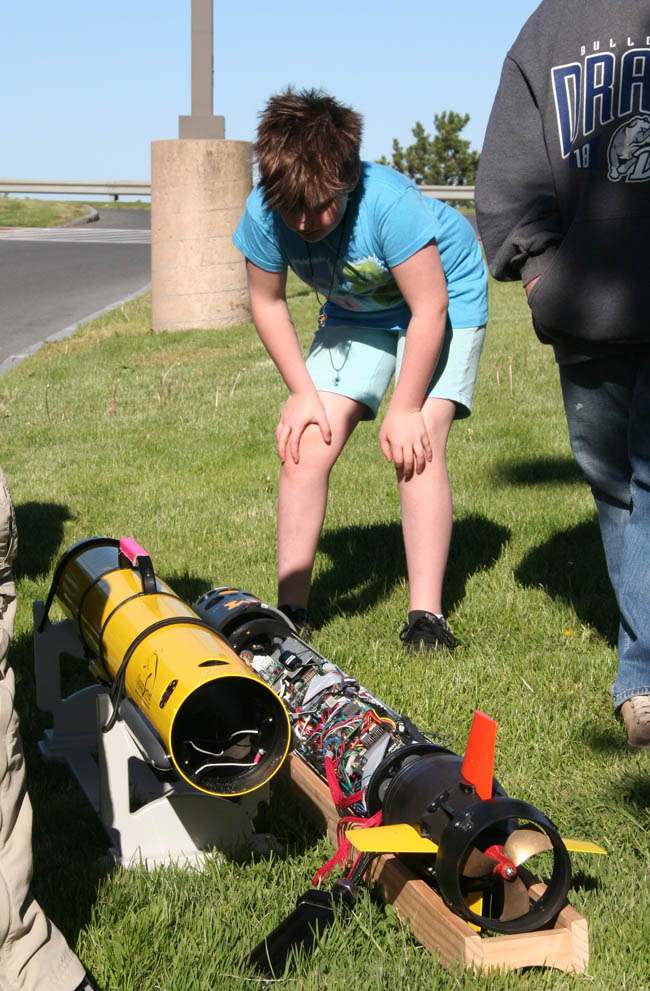
10-year-old Zeida Olson takes a close look at the AUV. She and her brother Arlo came to see the high-tech research equipment with their dad Eric who is a SUNY Oswego instructor and their mom Dinah.
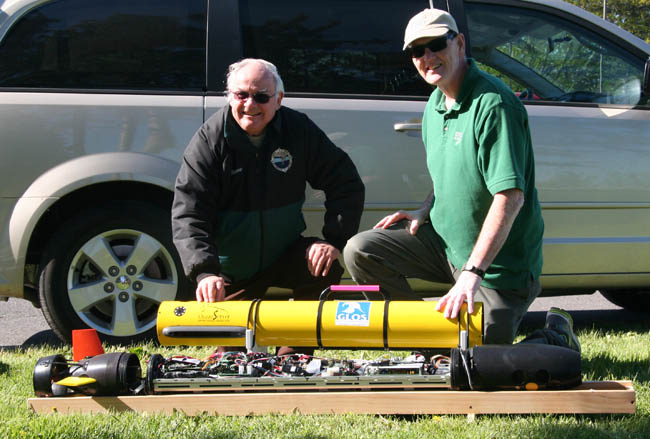
SUNY Oswego provided the shoreline launch site for the AUV mission. SUNY Oswego Meteorology Professor Alfred Stamm joined Dr. Greg Boyer to inspect the internal workings of the AUV.
AUV Retrieval
The Autonomous Underwater Vehicle, or AUV, brought to Lake Ontario by the Great Lakes Research Consortium at SUNY-ESF, Great Lakes Observing System, and New York Sea Grant for an intensive data collection mission completed its mission with the exception of reaching shore. The AUVs are often retrieved by boat, so, when the AUV battery power ran out after making the turn for shore, the project partners called on the Port of Authority of Oswego for retrieval assistance. The Port Authority of Oswego is believed to be the only Port Authority in the U.S. to offer the TowBoatUS towing, salvage and marine assistance service.
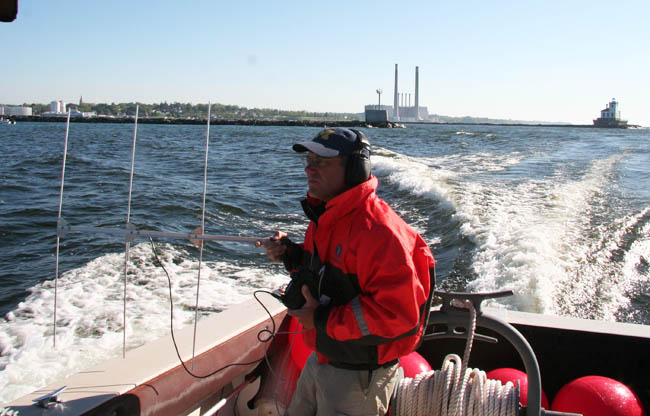
AUV Mechanical Technician Russ Miller from the Cooperative Institute of Limnology and Ecosystems Research at the University of Michigan Ann Arbor triangulates the signal from the AUV from aboard the TowBoatUS recovery boat provided by the Port Authority of Oswego.
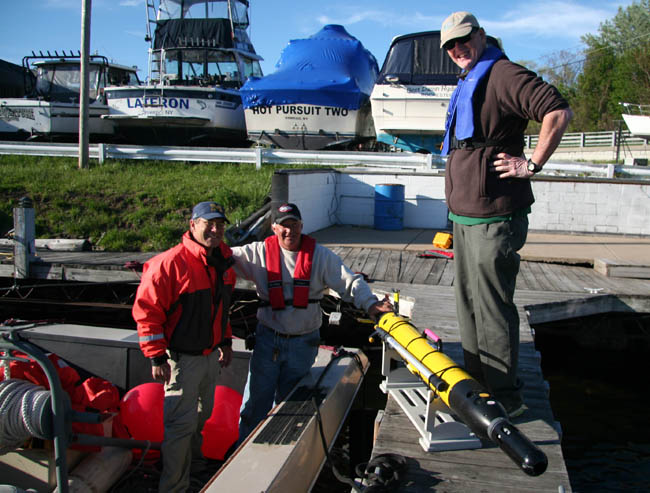
The AUV was safely back on shore by 6pm after 10 hours on the lake collecting thousands of datapoints. Left to right: AUV Mechanical Technician Russ Miller from the Cooperative Institute of Limnology and Ecosystems Research at the University of Michigan Ann Arbor, Port Authority of Oswego TowBoatUS Captain Bernie Bacon, and Great Lakes Research Consortium Director Dr. Greg Boyer of SUNY-ESF with the AUV returning to shore.
Photos by New York Sea Grant AUV Launch Coverage Team: Kara Lynn Dunn, Brian P. Whattam
More Info:
New York Sea Grant (NYSG), a cooperative program of Cornell University
and the State University of New York, is one of 33 university-based
programs under the National Sea Grant College Program (NSGCP) of the
National Oceanic and Atmospheric Administration (NOAA). The NSGCP
engages this network of the nation’s top universities in conducting
scientific research, education, training and extension projects designed
to foster science-based decisions about the use and conservation of our
aquatic resources. Through its statewide network of integrated
services, NYSG has been promoting coastal vitality, environmental
sustainability, and citizen awareness about the State’s marine and Great
Lakes resources since 1971.
For updates on Sea Grant activities:
www.nyseagrant.org has RSS,
Facebook,
Twitter, and
YouTube links. NYSG also offers a free e-list sign up via
www.nyseagrant.org/coastlines for NY Coastlines, its flagship publication, and Currents, its e-newsletter supplement, each distributed 3-4 times a year.